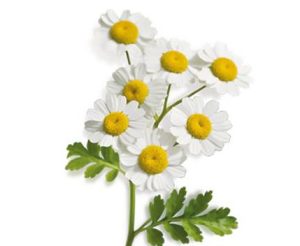
Family: Tanacetum parthenium (L.) Schultz Bip. (Asteraceae/Compositae)
Synonyms: Altamisa, Chrysanthemum parthenium (L.) Bernh., non (Lam.) Gaterau, Leucanthemum parthenium (L.) Gren & Godron, Pyrethrum parthenium (L.) Sm.
Other names: Feather Few, Febrifuge Plant, Featherfoil, Pyrethrum.
Features
Feverfew is native to Europe but common in the United States. Found occasionally in a wild state, but generally cultivated in gardens. The root contains a large percentage of inulin. The yellowish, porous wood has a distinct odour and a sweetish taste, very pungent, acrid, tingling, with a sialagogue (promotes secretion of saliva) effect. The flower resembles chamomile with its yellow disk and white petals, one to a stalk; flowering in June and July. The center stem grows to about 2 feet high with serrated-edge alternate leaves; very short hairs.
Bees are said to dislike this plant very much, and a handful of the flower heads carried in their vicinity will cause them to keep their distance.
Action
Aperient, carminative, tonic, emmenagogue, stimulant, anti-migraine, anti-rheumatic, febrifuge, bitter, carminative, tranquilliser, diuretic, antispasmodic, laxative, vermifuge, anti-inflammatory, vasodilator, anti-thrombotic (inhibits deposition of platelets)
Uses
Protects against clot formation, Meniere’s disease, vertigo, painful, absent or irregular menstruation, threatened miscarriage, psoriasis, inflammatory rheumatism, arthritis
The warming infusion of Feverfew upon the circulation influences the skin, nervous system, and the genitourinary organs and relieves the head of dizziness, brain and nerve pressure, and tensions of over-excitement.
Drs. Wood and Ruddock, in their book Vitalogy, say that it is “an admirable remedy for St. Vitus dance.”
Medicinal Parts
The whole herb.
Dosage
Limited information is available regarding the traditional dose of Feverfew. The doses (oral administration, adults) that have been recommended for migraine prophylaxis are as follows:
- Leaf (fresh) 2.5 leaves daily with or after food.
- Leaf (freeze-dried) 50 mg daily with or after food.
- Aerial parts (dried) 50–200 mg daily.
Solvents: Alcohol, boiling water (partial solvent).
Other recommended dosages are as follows:
Tincture: 10–30 drops in water every 2–3 hours, or as indicated by condition. Can be
used as tea, 1 teaspoonful to 1 cup of boiling water steeped for 1⁄2 hour; 2 cups a day in small mouthful doses.
Externally : The leaves boiled for hot compresses for pain of congestion or inflammation of the lungs, stomach, and abdomen is beneficial.
Homeopathic: Tincture of fresh plant for convulsions, delirium, dysentery, fevers, loquacity and rheumatism.
Feverfew leaf tea can particularly help migraines.
BEST WAY TO USE FEVERFEW: Most references recommend the cold infusion of Feverfew.
Source:
Herbal Medicines Third edition pub. 2007 by Joanne Barnes, Linda A Anderson, J David Phillipson
PDR for Herbal Medicine pub. 2000 by Joerg Gruenwald, PhD etal
Dr Shook’s Advance Course in Herbology
William Boericke – Pocket Manual Materia Medica
Ellingwood’s American Materia Medica, Therapeutics and Pharmacognosy
Petersen’s Materia Medica
The information provided here are for educational purposes only, and is meant to help users better understand health concerns. This information should not be interpreted as specific medical advice. Users should consult with a qualified healthcare provider for specific questions regarding therapies, diagnosis and/or health conditions, prior to making therapeutic decisions.
DISCLAIMER: THIS WEBSITE DOES NOT PROVIDE MEDICAL ADVICE
The information, including but not limited to, text, graphics, images and other material contained on this website are for informational purposes only. The purpose of this website is to promote broad consumer understanding and knowledge of various health topics. It is not intended to be a substitute for professional medical advice, diagnosis or treatment. Always seek the advice of your physician or other qualified health care provider with any questions you may have regarding a medical condition or treatment and before undertaking a new health care regimen, and never disregard professional medical advice or delay in seeking it because of something you have read on this website.